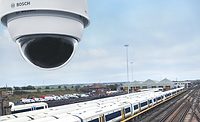Just a couple of blocks away from Zalud’s Blog headquarters,
Unlike most college campuses, DePaul’s two main campuses are interwoven with surrounding residential and commercial communities in
IP video technology enables the university to use one center to review incidences of interest occurring at any residence hall. A dispatcher monitors select cameras at the center. In addition, senior security staff can access camera views from any PC in case of emergencies.
Safety is top of mind at DePaul and so the university has been using surveillance systems for years. However, the analog systems in place were disparate systems, and required an associated DVR for each of the 16 cameras installed at every individual residence hall.
In addition, security staff realized that expanding the system would be a costly and time-consuming task in which coaxial cable would need to be laid in each residence hall for analog cameras, as opposed to network cameras, which could leverage the existing network infrastructure already in place.
As a result, DePaul chose Axis network cameras and the Milestone video management system. The implementation was accomplished in less than eight weeks and the new system required minimal training. DePaul also took advantage of Power over Ethernet (PoE), which now provides electricity to DePaul’s network cameras via the same cable as used for the network connection – as opposed to a power outlet. This reduces costs further and helped to simplify the implementation. For the future, DePaul will be installing smaller servers in the field which will provide backup for storing the video and minimize bandwidth use until off hours.
Said Bob Wachowski, director of public safety for DePaul, “We are extremely happy with how the installation proceeded and the final result. Beyond deterring crime and unruly behavior, the high clarity of the new system has enabled us to successfully identify perpetrators of several incidences. As a result, we’ve reduced campus crime and made our students feel safer.”
In the future, Wachowski said DePaul will replace the remaining analog cameras on campus and may implement wireless systems so that campus patrol cars, for example, have immediate access to incidents. In addition, DePaul intends to expand the use of Axis PTZ network cameras to other high-traffic outside areas of the campus to improve safety using their pan, tilt and zoom capabilities. These will be integrated with

